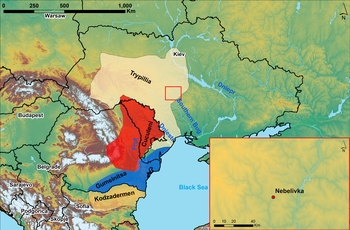Trypillia mega-sites of the Ukraine
J C Chapman, Bisserka Gaydarska, Marco Nebbia, Andrew Millard, Bruce Albert, Duncan Hale, Mark Woolston-Houshold, Stuart Johnston, Edward Caswell, Manuel Arroyo-Kalin, Tuuka Kaikkonen, Joe Roe, Adrian Boyce, Oliver Craig, David C Orton, Kate Hosking, G Rainsford-Betts, James Nottingham, Dan Miller, Sophia Arbeiter, Natalia Shevchenko, Galina Pashkevytch, Vitalii Rud, Mykhailo Videiko, Natalia Burdo, Konstantin Krementski, GEOINFORM Ukrainii, 2018. https://doi.org/10.5284/1047599. How to cite using this DOI
Data copyright © Emeritus Prof J C Chapman, Dr Bisserka Gaydarska, Dr Marco Nebbia, Dr Andrew Millard, Dr Bruce Albert, Duncan Hale, Mark Woolston-Houshold, Stuart Johnston, Edward Caswell, Manuel Arroyo-Kalin, Tuuka Kaikkonen, Joe Roe, Prof Adrian Boyce, Dr Oliver Craig, Dr David C Orton, Kate Hosking, G Rainsford-Betts, James Nottingham, Dan Miller, Sophia Arbeiter, Natalia Shevchenko, Galina Pashkevytch, Vitalii Rud, Mykhailo Videiko, Natalia Burdo, Konstantin Krementski, GEOINFORM Ukrainii unless otherwise stated
This work is licensed under the ADS Terms of Use and Access.
Primary contact
Emeritus Prof
J C
Chapman
Reader in Archaeology
Department of Archaeology
Durham University
South Road
Durham
DH1 3LE
England
Tel: 0191 378 0641
Resource identifiers
- ADS Collection: 3130
- DOI:https://doi.org/10.5284/1047599
- How to cite using this DOI
Introduction

The Anglo-Ukrainian Project 'early urbanism in Europe?: the case of the Trypillia megasites of Ukraine' arose out of the conundrum of what are currently the largest sites in the 4th millennium BC in Eurasia - both larger and earlier than the earliest cities in the Near East. A partnership was established between the Institute of Archaeology, Kyiv (Dr. Mykhailo Videiko) and Durham University (Professor John Chapman) to seek funds for a multi-disciplinary investigation of a single megasite - Nebelivka, Novoarkhangelsk District, Kirovograd Domain. The Project received funding for a trial season in 2009 and further major funding for a four-year Project (2012-5).
The Project defined seven objectives for investigation; an additional objective was added during the course of the fieldwork:
- the derivation of an accurate settlement plan of Nebelivka, using a combination of modern geophysical investigations of the entire site with satellite imagery from the 1960s onwards to reveal changes in site preservation;
- the production of an internal chronological sequence for Nebelivka: we cannot make progress in understanding a mega-site without an explicit estimate of the number of houses under coeval occupation;
- the setting of Nebelivka in a broader micro-regional settlement context through intensive, systematic fieldwalking;
- the placing of the Nebelivka micro-region in a regional settlement context through the analysis of satellite imagery of all Trypillia sites over 10ha in size;
- the palaeo-environmental assessment of the human impacts of a mega-site by comparison of local alluvial sequences (streambeds) with the overall vegetational history provided by peat-coring in larger basins;
- the development of an interpretative understanding of the foundation, growth and decline of Nebelivka;
- the comparative study of the emergence of towns elsewhere in the world in order to locate the Trypillia case in a long-term, global picture of the onset and collapse of regional social complexities;
- the experimental building and burning of two 2/3-size ‘Trypillia houses – one single-storey and one two-storey – to investigate the methods of house-building and house-burning and to assess the physical remains of the experimental houses in comparison with excavated house remains.
With the exception of Objective 2, all of these objectives have been fully met.
The (open access) monograph, associated with the archive, is also available:
Gaydarska, B. (ed.) 2020 Early Urbanism in Europe. The Trypillia Megasites of the Ukrainian Forest-Steppe. Warszawa / Berlin: De Gruyter Poland Ltd. doi: 10.1515/9783110664959. ISBN 978-3-11-066493-5. e-ISBN 978-3-11-066495-9.










